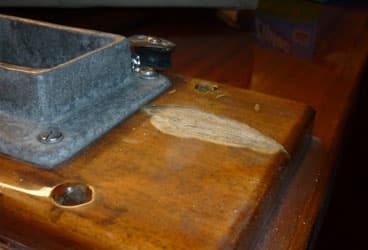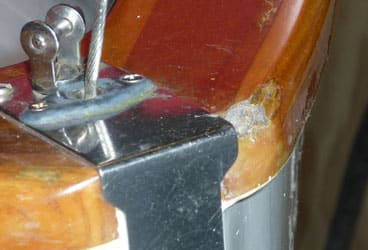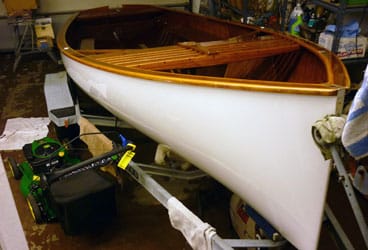
Sled368
I’m not a handy person. I mean, I’m not totally helpless with a toolbox, but I’ve never been Mr. Fix It. I just don’t have that mechanical ability that comes naturally to some people, like my friend Billy. Recently, a chain saw seized up on me. It had been working fine—I had the right mix of gas and oil in the tank, and the chain was well lubricated. But one day, I went to pull the cord, and it just wouldn’t budge. I took the plastic cover off the saw to reveal an utterly foreign, two-stroke universe populated with spark plugs and pistons, adjustment screws and springs, chain guides and gutters.
I was baffled, so I called Billy. He instantly began picking the machine apart, peeling away layer after layer until he got to the guts and identified the malfunction that was keeping the chain from circling properly. I still don’t know what he fixed, because the whole time he was messing around in there, I was staring at all the nuts, bolts, and washers on my picnic table, wondering how Billy was going to put the thing back together again. But he did, and in five minutes time he performed a form of mechanical surgery that I’d never have the gall to attempt.
So you can understand why I haven’t exactly plunged headfirst into the rehabilitation of my father’s cherished Thistle, The Sled. Dad is gaga about wooden boats, and the Sled was his first labor of love. He restored #1055 stick by stick before I can even remember, and by the time I started crewing at age eight or so, the whole family regarded the Sled as a varnished temple. I learned to race under a different set of rules. As forward crew, my two biggest responsibilities were to wipe the grit off my feet before stepping aboard and, during takedowns, not to let the spinnaker pole gouge the foredeck grating. Those proved to be pretty tough jobs. If you’re the one who moves the trailer from the hoist, how are you supposed to get back across the parking lot without picking up grit in your shoes? You leave your shoes on the boat, barefoot it across the hot blacktop, and then, at the bulkhead, use a rag to wipe your feet—that’s what you do! And how do you keep the spinnaker pole from clanking during a tumultuous takedown? You wrap it in 20 pounds of hockey tape, and you set it down like a test tube of nitroglycerin.

A rough spot
_
The Sled_ would be a pointless chore if not for one thing—the boat is blazing fast. The hull is stiff and light (we bolt on lead to be class legal), the bottom is perfectly fair, and the foils give the boat a magical sweet spot. There are times in a race when Dad says, “the Sled is dancing,” and he truly believes his boat is the fastest on the racecourse. The scoreboard proves otherwise time and again, but it’s a fine belief. And it’s the reason why I’m even attempting to rehabilitate the Sled when all signs point towards Fiberglass Easy Street. The Sled is fast, and the promise of speed is worth the effort. Plus, I can’t afford to buy my own boat, so this is my best option.
While I was living in Rhode Island the past few years before returning to Cleveland last fall, the Sled was sitting in a parking lot on a trailer with two flat tires. The covers were slowly rotting away, and in the places where the elements found their way to the wood, decay did diligent work. The varnish clouded and flaked, the epoxy cracked, and the wood grayed and split. Wasps built nests in the bow and under the rails, and the white vinyl floatation bags turned black with mildew. But for the most part, the boat’s in good shape. It needs a thorough sanding, some spot repairs, and a few coats of varnish. We need new covers, and we’ll have to replace some lines and hardware. All in all, it’s a manageable job for your average DIY-er. For me, it’s going to be a winter’s worth of work. And then I’ll have to figure out how to sail the thing.

Another rough spot
A few weeks ago, I replaced the tires on the trailer and hauled the boat to my parents’ house. This weekend, I took the first baby steps. I carved out a work area in their garage, hauled some gear upstairs, and slowly removed every piece of hardware. I took photos so I’d remember where everything goes, and placed each item in a Ziplock bag with a label like, “Topping lift block, port, on mast step just below grating.” It took me all weekend, and I didn’t even finish what I’d planned to accomplish on Saturday morning. I suppose that’s the first lesson: this is going to be a lot harder than I thought, and I didn’t think it was going to be easy.

_It took me all weekend just to remove the hardware. _
Now, I know I’m not the first sailor to bite off more than they can chew with a winter project. If you’re reading this going, “You know, it’d be a lot easier if you [fill in the blank],” I would greatly appreciate your input. You can share your boat-rehab advice by emailing me here. Thanks in advance. I’m going to need all the help I can get.









